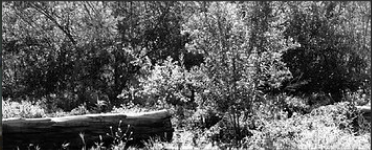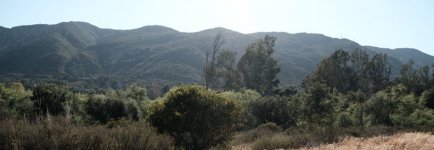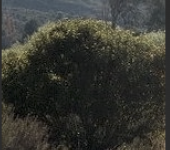markjwyatt
Well-known
The SOOC looks much more natural. RAW is the way to go with this image though. I would expose more for the sky, then bring up the shadows.'Had a shoot recently at a local park at the request of a couple of young ladies who are sisters. But the natural light was terribly harsh. The skies were almost clear and the sun was not diffused in any real way. We weren't using any supplemental lights or fill so I had to expose in a way to try to preserve enough highlight and shadow detail that would allow me to salvage something useful in post. The SOOC results looked dreadful to me when I was shooting and I was wondering whether I'd be able to come up with anything anyone would want to see.
Here is the straight out of the camera image followed by the edited image. Please note that the sky in the edited image looks a bit HDR to me, but that is very close to how it appeared at the time just as the sun was setting -- very saturated.
SOOC
4529 by Brusby, on Flickr
edited
4529 1 by Brusby, on Flickr
telenous
Well-known
I'm just reading for the first time this thread. I agree with the comment made earlier that there's editing and then there's manipulation. Even for artistic purposes it pays to tread lightly, on pain of distancing the photograph far too much from what it represents otherwise.
The examples in this thread are well-done even when compared with their SOOC siblings. Perhaps I would have preferred a somewhat lighter touch in the very last one (the edited version). FWIW.
The examples in this thread are well-done even when compared with their SOOC siblings. Perhaps I would have preferred a somewhat lighter touch in the very last one (the edited version). FWIW.
mapgraphs
Established
brusby
Well-known
I'd be very interested to see some of your results SOOC under a similar strong backlit situation.I get much better results than that SOOC, because I selectively meter. I still prefer RAW, but that is not a very good example. Your final product is beautiful, but you probably could have gotten pretty close SOOC if you selectively metered and locked it in. I use a Fujiflim XT-2, so I get a reasonable preview in the EVF. Maybe the Leica does not do that.
markjwyatt
Well-known
I must admit I do not have much available SOOC. Usually I shoot a RAW and jpg, but I lost my HD, so for many of my digital images I currently do not have access to the SOOC. I lost a lot of my high res lab negative scans also, BUT, I still have the negatives... I may try and get the HD recovered, but it is pricey, and not guaranteed.
I totally agree with using RAW for strong backlit scenes, but you do not have to totally lose the shadows in the SOOC (in the example I commented on they went to silhouette). With the Fujifilm XT-2 you can set the jpgs to boost shadows and it would still be considered SOOC. In that case you could get more of the sky also. @mapgraphs example also shows that you can recover shadow at least in his case even with jpegs. To me SOOC does not mean zero manipulation after the fact, just not using RAW.
Here are a couple of SOOC using ACROS sim (probably ACROS red or yellow sims) and not losing the sky, while exposing the foreground.

hillside by Mark Wyatt, on Flickr

kite by Mark Wyatt, on Flickr
I totally agree with using RAW for strong backlit scenes, but you do not have to totally lose the shadows in the SOOC (in the example I commented on they went to silhouette). With the Fujifilm XT-2 you can set the jpgs to boost shadows and it would still be considered SOOC. In that case you could get more of the sky also. @mapgraphs example also shows that you can recover shadow at least in his case even with jpegs. To me SOOC does not mean zero manipulation after the fact, just not using RAW.
Here are a couple of SOOC using ACROS sim (probably ACROS red or yellow sims) and not losing the sky, while exposing the foreground.

hillside by Mark Wyatt, on Flickr

kite by Mark Wyatt, on Flickr
Last edited:
markjwyatt
Well-known
Here is one that I took before I had a RAW processor, so it was SOOC. I did play with the brightness a bit.

Here is another, less extreme than your example. I could easily burn in the sky (with the jpeg), but chose not to.

Golden Oats and Greens by Mark Wyatt, on Flickr

Here is another, less extreme than your example. I could easily burn in the sky (with the jpeg), but chose not to.

Golden Oats and Greens by Mark Wyatt, on Flickr
Last edited:
brusby
Well-known
Mark, I don't think any of your examples prove your claim that by proper exposure you can get a better result sooc because the lighting in all of your photos is vastly different from mine. I'll address them individually.
Your first photo is not even backlit. It seems to have been taken shortly before or after noon because, according to the shadows, the sun was high in the sky. As a result, everything is broadly lit by the sun, including the sky, and the dynamic range of the scene is very limited. This is easily handled by almost any modern camera with no special metering requirements.
I won't even address the kite photo as it has such little to do with a drastically backlit scene particularly one with a person prominent in the frame whose face is in strong backlight.
Your third photo is backlit but it's hard to tell where the sun is except we know it appears not to be directly in the frame and it must be quite high in the sky because it is directly illuminating the nearest part of the foreground, which is so brightly lit it appears to be blowing out pretty severely. Even though the sun is not present in your sky, the sky is also almost blown out. I suggest that if the sun had been included in the sky, values would have likely been lost, possibly irreparably.
In my example the sun was about to set and thus it was extremely low in the sky and in the frame. The low angle means that almost all off the vegetation and the main subject in my photo are in hard shadow and blocked from direct light by the sun. The vast majority of objects in your photo are not in shadow but instead are translucent leaves that have the light either directly on them or transmitted through them. The only areas of real shadow somewhat comparable to my photo are illustrated in the crop of your photo I did below for illustration purposes. And as you can see the remaining shadow values are not unlike what is found in my sooc shot. If you had a person prominent in your frame he or she would have been rendered in a similar fashion to these shadows.
Finally your fourth and last shot is the most similar but there are very important differences which I'll address:
1) The sun appears to be pretty high in the sky. The reason that is so important is because it is directly illuminating the entire scene and in particular all of the foreground. I've addressed it above, but this is drastically different lighting than my photo where the sun is super low on the horizon and much less of the scene is in direct sunlight. I've taken the liberty of cropping out the bright foreground so your scene will more closely match the illumination of mine (2nd photo below).
2) Even though your dynamic range is significantly less, due in large part to not having the sun actually present in your sky, the sky over the mountains is almost blown out. If the sun had been included in the sky, like in my photo, it would just have added to the problem of blown out values in your sky.
3) the atmospheric haze (which is not present to any significant extent in my photo) is having the effect of diffusing the sunlight and filling in the shadows. It's most apparent in the mountain area. So in the mountains you have direct sunlight lighting much of the area plus diffused fill light from the haze. I don't have any of that in my photo with the exception of some direct sunlight possibly illuminating the very tops of the vegetation. But most of what you see in my photo is shaded from any direct sunlight unlike this image of yours.
4) If you look at the hard shadow areas of any of your photos -- as illustrated by the cropped images below, your shadow values are not much different from the shadow areas in my sooc image, except your shadows may be a bit darker. I suggest that if you had a person prominent in your frame, he or she would have looked very similar -- very dark verging on loss of major details. So, contrary to your claim, your choice of exposure has NOT had much of an effect on the hard shadows that are most similar to the shadows in my photo.
I suggest that the main reason your sooc photos look different than mine is because they are lit so differently, not because of any exposure wizardry on the photographers part.
If you'd like to prove your point, I suggest you provide a photo with much more dynamic lighting and include a person or object prominently displayed in the frame and completely backlit, for whom you want to maintain good tonal values appropriate to a main subject in a portrait photo.
Your first photo is not even backlit. It seems to have been taken shortly before or after noon because, according to the shadows, the sun was high in the sky. As a result, everything is broadly lit by the sun, including the sky, and the dynamic range of the scene is very limited. This is easily handled by almost any modern camera with no special metering requirements.
I won't even address the kite photo as it has such little to do with a drastically backlit scene particularly one with a person prominent in the frame whose face is in strong backlight.
Your third photo is backlit but it's hard to tell where the sun is except we know it appears not to be directly in the frame and it must be quite high in the sky because it is directly illuminating the nearest part of the foreground, which is so brightly lit it appears to be blowing out pretty severely. Even though the sun is not present in your sky, the sky is also almost blown out. I suggest that if the sun had been included in the sky, values would have likely been lost, possibly irreparably.
In my example the sun was about to set and thus it was extremely low in the sky and in the frame. The low angle means that almost all off the vegetation and the main subject in my photo are in hard shadow and blocked from direct light by the sun. The vast majority of objects in your photo are not in shadow but instead are translucent leaves that have the light either directly on them or transmitted through them. The only areas of real shadow somewhat comparable to my photo are illustrated in the crop of your photo I did below for illustration purposes. And as you can see the remaining shadow values are not unlike what is found in my sooc shot. If you had a person prominent in your frame he or she would have been rendered in a similar fashion to these shadows.
Finally your fourth and last shot is the most similar but there are very important differences which I'll address:
1) The sun appears to be pretty high in the sky. The reason that is so important is because it is directly illuminating the entire scene and in particular all of the foreground. I've addressed it above, but this is drastically different lighting than my photo where the sun is super low on the horizon and much less of the scene is in direct sunlight. I've taken the liberty of cropping out the bright foreground so your scene will more closely match the illumination of mine (2nd photo below).
2) Even though your dynamic range is significantly less, due in large part to not having the sun actually present in your sky, the sky over the mountains is almost blown out. If the sun had been included in the sky, like in my photo, it would just have added to the problem of blown out values in your sky.
3) the atmospheric haze (which is not present to any significant extent in my photo) is having the effect of diffusing the sunlight and filling in the shadows. It's most apparent in the mountain area. So in the mountains you have direct sunlight lighting much of the area plus diffused fill light from the haze. I don't have any of that in my photo with the exception of some direct sunlight possibly illuminating the very tops of the vegetation. But most of what you see in my photo is shaded from any direct sunlight unlike this image of yours.
4) If you look at the hard shadow areas of any of your photos -- as illustrated by the cropped images below, your shadow values are not much different from the shadow areas in my sooc image, except your shadows may be a bit darker. I suggest that if you had a person prominent in your frame, he or she would have looked very similar -- very dark verging on loss of major details. So, contrary to your claim, your choice of exposure has NOT had much of an effect on the hard shadows that are most similar to the shadows in my photo.
I suggest that the main reason your sooc photos look different than mine is because they are lit so differently, not because of any exposure wizardry on the photographers part.
If you'd like to prove your point, I suggest you provide a photo with much more dynamic lighting and include a person or object prominently displayed in the frame and completely backlit, for whom you want to maintain good tonal values appropriate to a main subject in a portrait photo.
Attachments
Last edited:
Dogman
Mentor
Here's a couple of extreme examples of JPEGs processed in LR and Silver Efex when the exposure is off and when everything is off. Normally my photos are a little better than these even before processing.
SOOC:
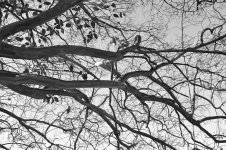
This is after processing.
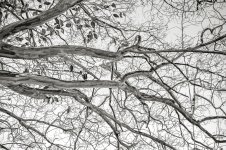
Doing a self portrait that went off the rails. I tilted camera too much and the background light fooled the metering. SOOC:
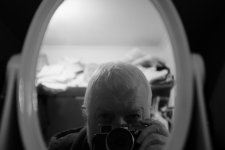
Here it is "fixed in post".
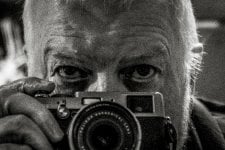
No such thing as SOOC for me.
SOOC:

This is after processing.

Doing a self portrait that went off the rails. I tilted camera too much and the background light fooled the metering. SOOC:

Here it is "fixed in post".

No such thing as SOOC for me.
markjwyatt
Well-known
I would say a processed jpeg is still SOOC as long as the processing is not extreme. I see in the photograph of the person that the quality did deteriorate in the shadows as you brought it up. That is why I mainly use RAW processing.
brusby
Well-known
Well you claimed you could do better, but when I asked you for examples to prove your point, you can't come up with anything remotely similar to the lighting situation you're critical of. It's really getting a bit tiring hearing people being critical and claiming they can do better, but when I ask for proof, miraculously they all seem to have lost their previous work and can't substantiate their claims.I would say a processed jpeg is still SOOC as long as the processing is not extreme. I see in the photograph of the person that the quality did deteriorate in the shadows as you brought it up. That is why I mainly use RAW processing.
So, exactly how do you know you can do better? Have you actually done it? If so lets see the results. Or were you just blowing smoke?
markjwyatt
Well-known
Agree largely. They were just the closest examples I could find. A problem with digital is you are forced to expose for the highlights (because they clip), and thus have to bring up the shadows in some way. On many digital cameras (such as the Fujifilm XT-2), you can bump up the shadows and perhaps drop the highlights a little as a fixed setting. If I were to go SOOC, I might create a mode for "extreme backlighting" and associate it with a function button. This is the same as modifying the curve in post, or bringing up shadows in post in a RAW image, but it is transferred to the camera, and done before creation of the final jpeg, and is still SOOC. If this does not work, it would not work in RAW processing either, because in a sense it is RAW processing, but shifted to the camera. I prefer RAW processing, because I want to have options when I decide how to process the image, but I still hunt for exposure and lock it in to make the the associated jpeg (recall I generally shoot a RAW and a high quality jpeg for each shot) close to what I envision at the time of the shot, with one of the main goals being to not clip the highlights in many cases. That is how I work, and there is no right or wrong way depending on your style, etc. For instancfe sometimes I take a RA image and PURPOSEFULLY drop out the shadows to silhouette, but his is my choice (see example):Mark, I don't think any of your examples prove your claim that by proper exposure you can get a better result sooc because the lighting in all of your photos is vastly different from mine. I'll address them individually.
Your first photo is not even backlit. It seems to have been taken shortly before or after noon because, according to the shadows, the sun was high in the sky. As a result, everything is broadly lit by the sun, including the sky, and the dynamic range of the scene is very limited. This is easily handled by almost any modern camera with no special metering requirements.
I won't even address the kite photo as it has such little to do with a drastically backlit scene particularly one with a person prominent in the frame whose face is in strong backlight.
Your third photo is backlit but it's hard to tell where the sun is except we know it appears not to be directly in the frame and it must be quite high in the sky because it is directly illuminating the nearest part of the foreground, which is so brightly lit it appears to be blowing out pretty severely. Even though the sun is not present in your sky, the sky is also almost blown out. I suggest that if the sun had been included in the sky, values would have likely been lost, possibly irreparably.
In my example the sun was about to set and thus it was extremely low in the sky and in the frame. The low angle means that almost all off the vegetation and the main subject in my photo are in hard shadow and blocked from direct light by the sun. The vast majority of objects in your photo are not in shadow but instead are translucent leaves that have the light either directly on them or transmitted through them. The only areas of real shadow somewhat comparable to my photo are illustrated in the crop of your photo I did below for illustration purposes. And as you can see the remaining shadow values are not unlike what is found in my sooc shot. If you had a person prominent in your frame he or she would have been rendered in a similar fashion to these shadows.
Finally your fourth and last shot is the most similar but there are very important differences which I'll address:
1) The sun appears to be pretty high in the sky. The reason that is so important is because it is directly illuminating the entire scene and in particular all of the foreground. I've addressed it above, but this is drastically different lighting than my photo where the sun is super low on the horizon and much less of the scene is in direct sunlight. I've taken the liberty of cropping out the bright foreground so your scene will more closely match the illumination of mine (2nd photo below).
2) Even though your dynamic range is significantly less, due in large part to not having the sun actually present in your sky, the sky over the mountains is almost blown out. If the sun had been included in the sky, like in my photo, it would just have added to the problem of blown out values in your sky.
3) the atmospheric haze (which is not present to any significant extent in my photo) is having the effect of diffusing the sunlight and filling in the shadows. It's most apparent in the mountain area. So in the mountains you have direct sunlight lighting much of the area plus diffused fill light from the haze. I don't have any of that in my photo with the exception of some direct sunlight possibly illuminating the very tops of the vegetation. But most of what you see in my photo is shaded from any direct sunlight unlike this image of yours.
4) If you look at the hard shadow areas of any of your photos -- as illustrated by the cropped images below, your shadow values are not much different from the shadow areas in my sooc image, except your shadows may be a bit darker. I suggest that if you had a person prominent in your frame, he or she would have looked very similar -- very dark verging on loss of major details. So, contrary to your claim, your choice of exposure has NOT had much of an effect on the hard shadows that are most similar to the shadows in my photo.
I suggest that the main reason your sooc photos look different than mine is because they are lit so differently, not because of any exposure wizardry on the photographers part.
If you'd like to prove your point, I suggest you provide a photo with much more dynamic lighting and include a person or object prominently displayed in the frame and completely backlit, for whom you want to maintain good tonal values appropriate to a main subject in a portrait photo.

Joshua Tree at Sunset by Mark Wyatt, on Flickr
So in summary if you create a setting in your camera that (for instance)
1. Bumps up the shadows two stops (or even 3 if you want)
2. maybe drops the highlights 1/2 stop
3. Optionally associate it with a function button for strongly backlit scenes
You would probably get an acceptable image shooting into a sunset, and it would be SOOC, and would have the same quality as a RAW processed shot (but you lose the option to go another direction later, because once you create the jpeg, you lose the extra dynamic range in the SOOC shot you otherwise could have available in the RAW image). @Dogman - I think you can do that with your camera also (X100 /F/V?).
Last edited:
brusby
Well-known
Mark this is just conjecture. You said you could do better. Talk is cheap. I suggest you show your results or retract your statement until you actually DO it.Agree largely. They were just the closest examples I could find. A problem with digital is you are forced to expose for the highlights (because they clip), and thus have to bring up the shadows in some way. On many digital cameras (such as the Fujifilm XT-2), you can bump up the shadows and perhaps drop the highlights a little as a fixed setting. If I were to go SOOC, I might create a mode for "extreme backlighting" and associate it with a function button. This is the same as modifying the curve in post, or bringing up shadows in post in a RAW image, but it is transferred to the camera, and done before creation of the final jpeg, and is still SOOC. If this does not work, it would not work in RAW processing either, because in a sense it is RAW processing, but shifted to the camera. I prefer RAW processing, because I want to make to have options when I decide how to process the image, but I still hunt for exposure and lock it in to make the the associated jpeg (recall I generally shoot a RAW and a high quality jpeg for each shot) close to what I envision at the time of the shot, with one of the main goals being to not clip the highlights in many cases. That is how I work, and there is no right or wrong way depending on your style, etc.
So in summary if you create a setting in your camera that (for instance)
1. Bumps up the shadows two stops (or even 3 if you want)
2. maybe drops the highlights 1/2 stop
3. Optionally associate it with a function button for strongly backlit scenes
You would probably get an acceptable image shooting into a sunset, and it would be SOOC, and would have the same quality as a RAW processed shot (but you lose the option to go another direction later, because once you create the jpeg, you lose the extra dynamic range in the SOOC shot you otherwise could have available in the RAW image).
muser53
MUSER53
Since the birth of photography photographers have grappled with the limitations of the medium. Virtually all the great or shall I say memorable photographs I can think of have been manipulated in one way or another. Even the masters of previsualization (think Ansel Adams, Irving Penn and Minor White) were masters in the darkroom. HCB (even he claimed otherwise) routinely cropped images. His work was typically printed by others (see Voja Mitrovic, Printer to the Greats (Part I)). This in no way distracts from the stunning quality of their respective work.
We should remember that any photograph (by it's nature) is a 2D abstraction of our three dimensional world. Every photographer/artist strives to create an image that will impart an experience and reaction from their viewers. If an image straight out of the camera achieves this so be it. If not alterations in the darkroom or in post can fulfill the artists intentions in a way the unaltered image would not.
Personally I think of photos SOOC somewhat like a first draft of a written story. A bit of careful editing usually improves the final presentation.
We should remember that any photograph (by it's nature) is a 2D abstraction of our three dimensional world. Every photographer/artist strives to create an image that will impart an experience and reaction from their viewers. If an image straight out of the camera achieves this so be it. If not alterations in the darkroom or in post can fulfill the artists intentions in a way the unaltered image would not.
Personally I think of photos SOOC somewhat like a first draft of a written story. A bit of careful editing usually improves the final presentation.
markjwyatt
Well-known
I will take that as a challenge then next time I take the Fuji out (and that is not often). In the mean time, see this video. This is not conjecture. If it works in RAW, it can be done in camera. It is not as good as you can get in RAW since it is limited to 2 stops, but I think there may be other permanent settings that can go more, not sure though.Mark this is just conjecture. You said you could do better. Talk is cheap. I suggest you show your results or retract your statement until you actually DO it.
This ad hoc adjustment, and limited to 2 stops of lightening the shadows
Here is another:
brusby
Well-known
Sorry Mark, you said YOU could do better. But when I asked you to prove it, you couldn't. I don't have time to watch a bunch of videos of you trying to prove your point another way. When you've actually done what you said you could do, I'd be happy to check it out.
markjwyatt
Well-known
Fair enough. I spoke but couldn't bring home the bacon. RAW is the way to go, I do agree.
Dogman
Mentor
I would say a processed jpeg is still SOOC as long as the processing is not extreme. I see in the photograph of the person that the quality did deteriorate in the shadows as you brought it up. That is why I mainly use RAW processing.
If the photo you're speaking of is my self-portrait, this deterioration of the image is what I was trying to get. I love the grainy, dark, ugly look with nothing really sharp anywhere. In some cases I prefer it to the ultra smooth look of normal digital. And I really thought the look matched my ugly, grainy old face.🤪
Share:
-
This site uses cookies to help personalise content, tailor your experience and to keep you logged in if you register.
By continuing to use this site, you are consenting to our use of cookies.




